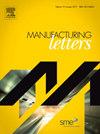An unconstrained and non-redundant identification method of geometric errors and compensation of machine tools by X-AX Laserbar
IF 2
Q3 ENGINEERING, MANUFACTURING
引用次数: 0
Abstract
Efficient and accurate measurement and identification of geometric errors are crucial for improving the precision of CNC machine tools. The X-AX Laserbar, as a novel tool for indirect measurement, has not been extensively studied for the identification of geometric errors in machine tools. In this paper, the geometric error model for a three-axis machine tool is established to illustrate the multilateration measurement principle of the laserbar, and a non-redundant and unconstrained identification method is proposed to identify these geometric errors. This method avoids the use of redundant parameters and additional constraints by employing pose error twists to describe the geometric errors. These pose error twists are identified in a transitional coordinate system, and then the geometric errors will be identified in the machine coordinate system by deriving the relationship between the pose errors and geometric errors. The proposed method is validated with the VMC-850E three-axis machine tool. The geometric error measurement using a laserbar is completed in about 40 min, showing great efficiency. The experimental results indicate that the proposed method is capable of accurately identifying the 17 geometric errors required for error compensation. The identified geometric errors are then applied to the machine tool’s accuracy improvement through error compensation. The results show that the actual geometric errors are controlled to a low level. The proposed method can efficiently measure the geometric errors of three-axis machine tools and contribute significantly to improving their geometric accuracy.
利用 X-AX 激光条对机床几何误差和补偿进行无约束和非冗余识别的方法
高效准确地测量和识别几何误差对于提高数控机床的精度至关重要。X-AX 激光条作为一种新颖的间接测量工具,在识别机床几何误差方面尚未得到广泛研究。本文建立了三轴机床的几何误差模型,以说明激光条的多尺度测量原理,并提出了一种非冗余、无约束的识别方法来识别这些几何误差。该方法采用姿态误差扭曲来描述几何误差,从而避免了冗余参数和额外约束的使用。在过渡坐标系中识别这些姿态误差扭曲,然后通过推导姿态误差和几何误差之间的关系,在机器坐标系中识别几何误差。建议的方法通过 VMC-850E 三轴机床进行了验证。使用激光条测量几何误差只需约 40 分钟,效率极高。实验结果表明,所提出的方法能够准确识别误差补偿所需的 17 个几何误差。识别出的几何误差可用于通过误差补偿提高机床精度。结果表明,实际几何误差被控制在较低水平。所提出的方法可以有效地测量三轴机床的几何误差,对提高机床的几何精度大有裨益。
本文章由计算机程序翻译,如有差异,请以英文原文为准。
求助全文
约1分钟内获得全文
求助全文
来源期刊

Manufacturing Letters
Engineering-Industrial and Manufacturing Engineering
CiteScore
4.20
自引率
5.10%
发文量
192
审稿时长
60 days
 求助内容:
求助内容: 应助结果提醒方式:
应助结果提醒方式:


